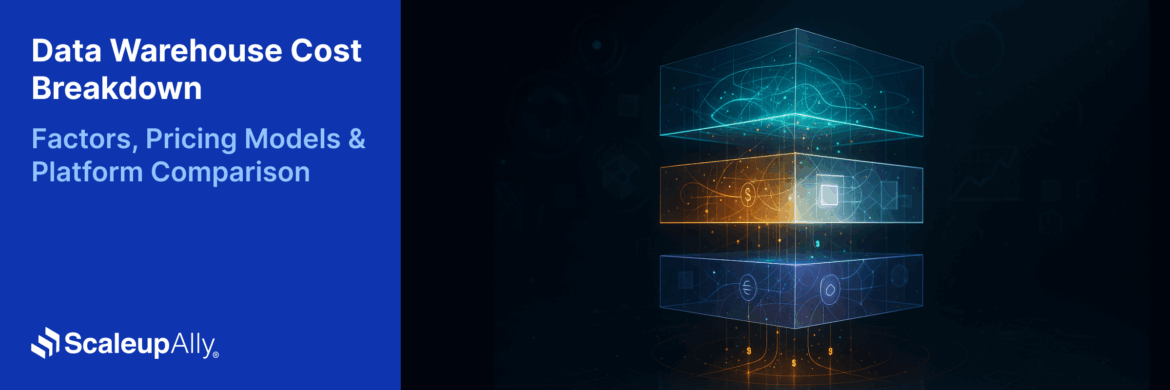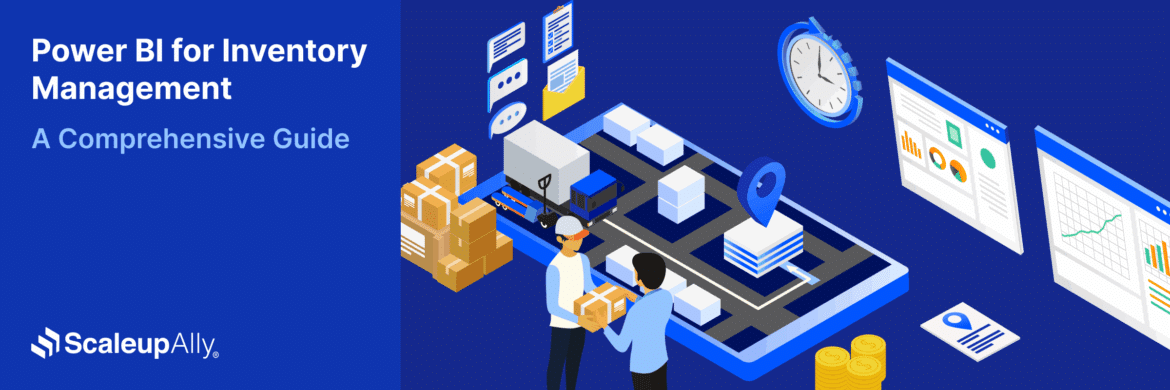
Healthcare Business Intelligence: Enhancing Healthcare Industry
Tarsem Singh | September 29, 2024 , 13 min read
Table Of Content
The accumulation of data in health facilities has outpaced our capacity to use it to improve operating efficiency and clinical quality. Moreover, hospitals have lagged in adopting thoughtful analytic frameworks to allow healthcare providers to capitalise upon existing data stores. In this blog, we examine the applications of business intelligence in healthcare organisations and how patient outcomes and related operational facilities can be improved.
What is Healthcare Business Intelligence?
- What is Healthcare Business Intelligence?
- Key Components of Healthcare Business Intelligence
- Benefits of Implementing BI in Healthcare
- How to Implement Business Intelligence in Healthcare
- Challenges in Adopting Healthcare Business Intelligence
- Future Trends in Healthcare Business Intelligence
- How can Scaleupally help you in implementing BI in healthcare
- Conclusion
- Frequently Asked Questions
When healthcare institutions utilise the data they collect from various sources in the facility (patient records, hospital systems, or even billing data) into information they can interpret and make meaning out of, it is termed Healthcare Business Intelligence. This process is carried out to identify inefficiencies or patterns that can help them deliver better patient care. How do healthcare centres prepare for patient demand during flu seasons if they are unable to predict an outbreak? Healthcare BI allows health centres access to clear data and information they can use to improve their services and even cut costs.
Key Components of Healthcare Business Intelligence
Business intelligence in healthcare is made of some elements that make the work as it is supposed to. They can be considered as the building blocks of healthcare BI. Below is a breakdown of what makes it a viable product:
1. Data Collection
Everything starts with data and this data is the foundation of healthcare BI. Data collection begins from different sources within the facility. These sources include health insurance, billing, patient records (EHRs), patient management systems, and other sources unique to each facility.
2. Data Integration
The point of the data collection is to collect them in one place so that you have a complete view of what you are working with. This way, you do not have to jump from different sources or software to get what you need as everything is available in a single, unified view. This drives efficiency in analyzing data from a single source rather than from separate systems or locations.
3. Data Analysis and Reporting
Once the data is collected and integrated, it is time to begin work. To find patterns, trends, and even abnormalities, data analytical tools are used to analyze the data. From this analysis, reports are generated to highlight findings that were not obvious in a format that is easy for anyone to understand.
4. Data Visualization
Numbers and other data forms can be confusing for some and that has been thought through for that matter. At a glance, anyone can easily understand what they are looking at based on easy-to-read charts, graphs, and dashboards. Imagine looking at your data and spotting a spike. You can easily tell if that is good or bad depending on the circumstance without getting bogged down in the details.
5. Predictive Analytics
One of the most exciting things about using BI is gaining the ability to predict future trends. You can do this by using past data with business intelligence. The insights generated enable hospitals to foresee patient admissions, staffing needs, or even potential outbreaks to prepare adequately for what comes next.
6. Performance Metrics and KPIs
Key Performance Indicators (KPIs) evaluate the performance of certain areas–patient care, cost management, or operational efficiency–to track progress and to also highlight areas that need attention for improvements.
7. Data Governance and Security
Healthcare data is sensitive, and it must be secure and comply with healthcare regulations (like HIPAA). With data governance in the picture, this ensures that the data is accurate, secure, and handled properly, to safeguard patient privacy.
Benefits of Implementing BI in Healthcare
Business intelligence for healthcare offers benefits that make a difference in patient healthcare and the overall operations of the health facility. Here’s a look at some of the key advantages:
1. Improving The Quality of Patient Care
One of the biggest wins of BI is that healthcare providers can make decisions that are based on facts and more accurate and detailed information rather than guesswork. A wrong move could cost the life of a patient, so BI essentially plays a big role in better health outcomes for patients as access to more relevant data means that healthcare providers can now understand patient needs and identify trends in order to offer improved treatment and care.
2. Improving overall efficiency
Healthcare business intelligence benefits not only the clients of health centers but also the health center’s operations. When healthcare providers take the time to analyze data transformed by clinical business intelligence, they can make smarter decisions about how to use their resources. For example, they can figure out the best times to have staff on duty, which can help reduce patients’ waiting time. This not only improves patient experience but also helps avoid situations where emergency rooms might become crowded.
3. Reducing operational costs
Healthcare organizations can also spot inefficient areas and waste. For instance, they can reveal instances of unnecessary medical tests that may not provide any real benefit to patients. Similarly, they can highlight situations where patients might be staying in the hospital longer than needed, which can put a strain on resources. Additionally, BI can point out when certain departments have more staff than actually required. With this kind of valuable information, healthcare providers can make informed decisions to reduce expenses while still ensuring that patients receive the high-quality care they deserve.
4. Forecasting abilities
Not only can you track current trends and findings with BI, but you can also predict future trends. For instance, it can assist in anticipating how many patients might come in during flu season, helping hospitals prepare for the surge. Additionally, it can identify which patients might face a higher chance of being readmitted after treatment. This forward-thinkingness enables healthcare providers to get ready in advance and use their resources in a smarter way, ensuring they are prepared for the challenges ahead.
5. Improved compliance and risk oversight
Several strict regulations must be adhered to in healthcare especially when dealing with patient data. You can monitor compliance with BI by tracking relevant metrics to stay in line with regulations like HIPAA. It can also flag potential risks, such as billing errors or patient safety issues before they become larger problems.
6. Evidence-based decision making
At this point, it should be increasingly clear that decisions pertaining to healthcare shouldn’t just come from instincts or outdated information that may not be relevant anymore but based on real-time data for more accurate, timely choices that can have a direct impact on improving care, patient satisfaction, and operational efficiency.
7. Patient Satisfaction
When operations are running smoothly and patients are receiving personalized care, it naturally makes everyone satisfied with the quality of care–both clients and healthcare providers. This sense of satisfaction comes from the understanding that their individual experiences matter. BI tools can track and analyze patient feedback, helping healthcare providers identify issues and respond to them in a timely and effective manner, ensuring that every patient’s voice is heard and acted upon. This not only improves care but also helps build trust and confidence in the healthcare system.
How to Implement Business Intelligence in Healthcare
You can implement business intelligence into your healthcare systems with a clear plan without breaking a sweat. Here’s a step-by-step guide to help healthcare organizations get started:
STEP 1. Specify desired outcomes
We are pretty sure you can already identify areas in your health organization where BI will be most useful. Great, get to work. List what you would like to achieve with BI. Do you wish to provide better care for your patients, make your operations run more smoothly, cut down on expenses, or improve the way you report information? If you can pinpoint how BI can be most impactful, these goals will guide the entire implementation process.
STEP 2. Involve stakeholders
Implementing BI will positively affect every department of your organization; it is only natural to involve key stakeholders from various departments, such as administration, IT, clinical staff, and finance. Each department has its perspective and expertise that can be incredibly valuable. Listening to them will give you additional insights into what more the organization would need and how you can ensure the BI solution aligns with organizational goals. Everyone will feel involved and invested in the outcome, making it much more likely to succeed.
STEP 3. Review current data repositories
Take stock of your data. Review your current systems, such as electronic health records (EHR), billing software, and patient management systems. Know where your data originates and how reliable it is. Without a good understanding of your data sources and their accuracy, it would be difficult to create an effective strategy that serves your needs.
STEP 4. Ensure Data Integration
Set up processes to combine data from various sources into a unified system. You might need to collaborate with IT specialists to create systems to ensure real-time data flow. This can take some time and planning, but it helps ensure that all the data you need is in one place and can be accessed without any delays.
STEP 5. Train Your Team
Even though BI tools are easy to use, a little training can help your staff get started. They can learn to interpret data, generate reports, and apply what they learn from the information to improve their work. It’s not enough for just a few people to understand the tools; everyone involved should be able to use them confidently.
STEP 6. Start Small and Scale
Start with a small-scale project that targets one specific area, such as reducing patient wait times or improving billing accuracy. Take time to track the outcomes and see how effective the changes are. It’s also important to gather input from those involved. Once you have a clear idea of the results and any feedback, you can consider broadening these efforts to other parts of the organization.
STEP 7. Measure and assess progress
Continuously assess the effectiveness of your BI implementation. Use KPIs to measure progress against your objectives. Review what’s working and not regularly and adjust your strategy accordingly.
Challenges in Adopting Healthcare Business Intelligence
Despite all the numerous benefits we have listed, implementing healthcare business intelligence comes with its own set of challenges. Here are some common hurdles that healthcare organizations might face:
1. Data Silos
Healthcare data often exists in separate systems, electronic health records (EHRs), patient billing systems, or lab databases, which can make integration difficult. Breaking down these data silos is essential, but it can be a complex process, especially if systems are outdated or incompatible.
2. Data Quality and Accuracy
BI relies on clean, accurate data to provide meaningful insights. However, healthcare data can be inconsistent, incomplete, or even erroneous. Connecting these various sources of data is important, but it’s not always easy. The process can become more complicated when the systems involved are outdated or incompatible.
3. Privacy and Security Concerns
Handling sensitive patient information brings significant privacy concerns. Healthcare organizations must ensure their BI systems comply with regulations like HIPAA and protect against data breaches. Balancing access to data with strict security measures can sometimes slow down implementation.
4. Resistance to Change
Adopting new technology often meets resistance from staff, especially if they’re used to certain workflows. Physicians, administrators, and staff might be hesitant to embrace BI tools if they don’t see the immediate benefit or if they think they may never learn to use new technologies.
Future Trends in Healthcare Business Intelligence
1. Integration of IoT and Wearable Data
As more people start using devices like fitness trackers and smartwatches, which are part of the growing Internet of Things (IoT), healthcare professionals will be able to get patient information in real-time, even when patients are not in the clinic. This constant flow of data will give doctors and healthcare teams a much better understanding of a patient’s overall health. Access to this kind of information will make it easier to catch potential health issues early and manage long-term conditions more effectively.
2. Natural Language Processing (NLP)
NLP technology will play a larger role in BI by allowing healthcare organizations to analyze unstructured data, such as doctors’ notes, patient reviews, and medical records. This can unlock valuable insights that are often buried in text, making it easier to understand trends and improve patient care.
3. Focus on Population Health Management
BI will increasingly be used to manage the health of entire populations, not just individual patients. By analyzing data on a broader scale, healthcare providers can identify at-risk groups, monitor public health trends, and implement preventative measures to improve community outcomes.
How can Scaleupally help you in implementing BI in healthcare
ScaleupAlly helps healthcare providers make the most out of business intelligence with custom software solutions that meet the needs of every healthcare’s challenges. We design intuitive BI platforms that are easy to use, offering clear, actionable insights for both doctors and administrators. Along with the integration, we provide training and support to ensure your team gets the most out of the system. Partner with ScaleupAlly for BI solutions that drive real, measurable improvements in your organization. Schedule a free consultation today.
Conclusion
Healthcare Business Intelligence is transforming how medical help is provided in health institutions. We are moving toward a future where data will drive medical decisions, and patients will be the center of care, paving the way for new opportunities for better outcomes and a more resilient healthcare ecosystem. It’s about time we build a more resilient, data-driven healthcare future.
As the saying goes, “The best time to plant a tree was 20 years ago. The second best time is now.”
Frequently Asked Questions
Q: What is business intelligence in healthcare?
Business Intelligence in healthcare refers to the technologies and strategies used to analyze data from various sources to improve decision-making and enhance patient care within healthcare organizations.
Q: How big is the healthcare business intelligence market?
The healthcare business intelligence market is projected to grow substantially, with estimates suggesting it could reach between USD 16.9 billion and USD 25.86 billion by 2032.
Q: What are the top tools for healthcare BI?
Some of the leading tools for healthcare business intelligence include Tableau, Microsoft Power BI, Qlik, and SAS. These platforms offer advanced analytics, user-friendly dashboards, and integration capabilities, enabling healthcare organizations to transform data into actionable insights effectively.
Q: How can BI improve patient outcomes?
Business Intelligence can enhance patient outcomes by providing healthcare professionals with timely data on patient health, enabling predictive analytics for risk assessment, and facilitating personalized treatment plans. This data-driven approach leads to better care coordination and improved overall patient health.
References
Related Blogs

Data Warehouse Cost Breakdown: Factors, Pricing Models & Platform Comparison
Discover how much a data warehouse costs in 2025. Explore pricing models, key factors, and platform comparisons to plan your data budget effectively.
Tarsem Singh
Nov 6 ,
14 min read

How Much Do Integrations Cost? [Pricing Breakdown & Key Insights]
Learn how much integrations cost, key factors influencing pricing, hidden expenses to avoid, and effective ways to reduce integration costs.
Tarsem Singh
Nov 6 ,
9 min read

Power BI for Inventory Management: A Comprehensive Guide
Explore the hidden power of Power BI for inventory management and how it provides businesses with powerful analytics and visualization capabilities.
Tarsem Singh
Oct 8 ,
19 min read


